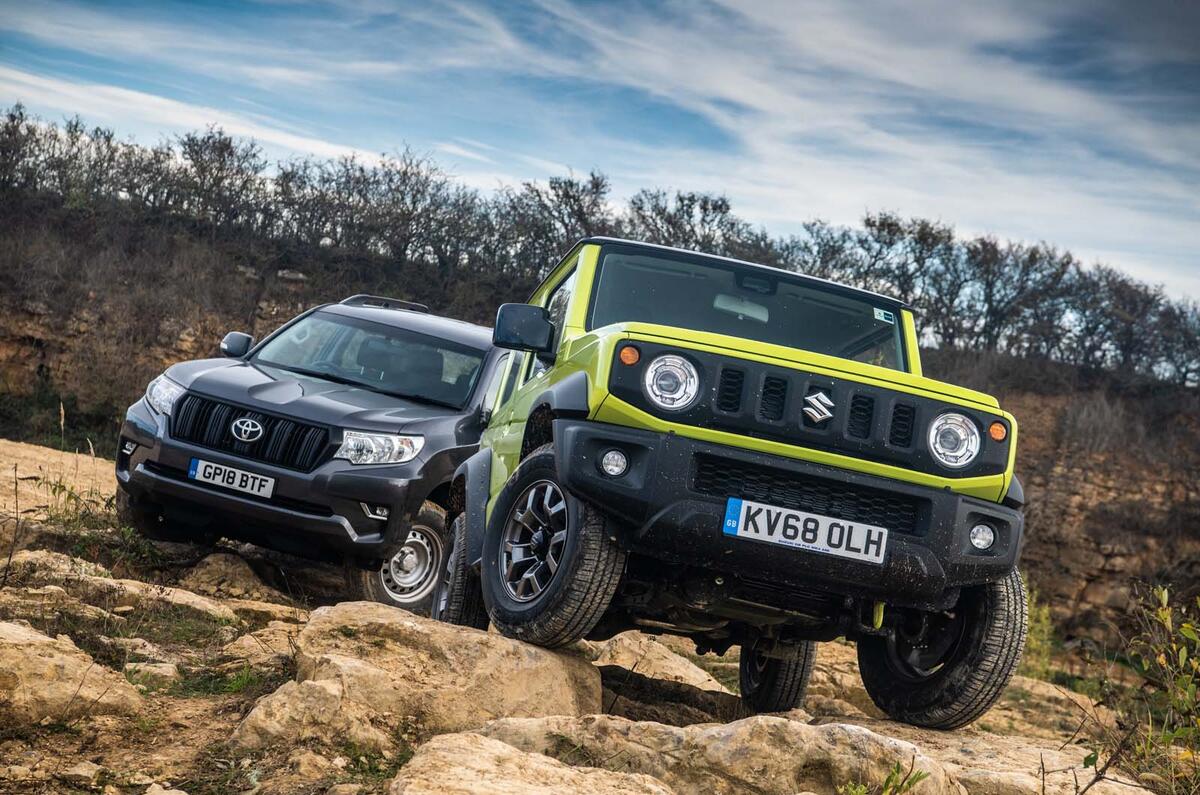The one and only small, lightweight four-wheel drive is how Suzuki pitches the Jimny – which sounds fair. At 3.6 metres long it’s shorter even than its predecessor, and at 1135kg it weighs about as much as a heavily laden tool chest.
So to test its off-road chops, here I am, having it scamper up hills in a disused quarry. And it’s very good: a mountain goat or a spring gazelle among a herd of beasts of burden, one of which – a Toyota Land Cruiser – is dutifully following in its tyre tracks.

The latest fourth-generation Jimny is tiny in relation to the Land Cruiser. It remains a kei-class car in Japan (which means, without the flared wheel arches and bumpers of this export model, it’s tinier still), and that was the idea in the first place. The Jimny was conceived as a practical, rugged vehicle that looked ‘Jeepy’, and in 1970 was the first four-wheel-drive vehicle to meet the miniature kei-class regulations.
Weirdly, its generations get longer: the first car remained on sale for 11 years; the second SJ, the one people really knew as a ‘Suzuki Jeep’ and which gained a reputation for falling over, was on sale for 17 years; and the last for 20.
This latest version is shorter than its predecessor but to my eyes looks bigger, perhaps due to more chiselled edging, giving it a more Defender/Jeep/Mercedes-Benz G-Class/original SJ-like appearance.
But it feels no bigger inside. The Jimny is unashamedly compact, and though it can fit occupants in the rear, if you fold down the thin rear seat backs to create a flat plastic load floor, from the front seat you can reach deep into the load bay – which I reckon would take a hay bale or a couple of spaniels. With the rear chairs upright, there’s barely a sliver of boot, but the Jimny never was a family car.
It has resisted the move to accepting the mechanical layout of one, too. Where other small off-roaders have adopted a monocoque, the Jimny retains a separate chassis with live axles sprung off it, both front and rear. Where most cars get a turbocharged engine, the Jimny’s naturally aspirated four-cylinder unit is a 1.5 of just 100bhp at 6000rpm and 95lb ft at 4000rpm – high revs for a 4x4, which is why the low-range transfer gearbox is proving a considerable help as it springs in and out of steep troughs with precious little chance of grounding its extremities.

































Join the debate
Add your comment
Share a Piece of Info With Thanking
Great! Your article is really very interesting and is full with information. So, Thanks to you for sharing this article with us. I've enjoyed by reading it. Do you know that the sony embarked on road tests of its Vision-S concept. Unfortunately, Sony is not going to enter the car business. Instead, all work on the concept, in fact, like the car itself, is simply “Sony's contribution to the evolution of cars”, but it will be very interesting to see which of the technologies implemented in the concept will be used in production cars of other companies. Recall that carzaamin(.)com/blog/japanese-used-cars-for-sale-in-pakistan/ is equipped with at least 33 sensors that detect people and objects not only outside the car, but also inside the four-seater cabin. It is also worth noting the huge number of screens on the dashboard, as well as the 360 Reality Audio system, which creates a three-dimensional sound effect, placing speakers on each seat
Price
The one major thing missing is the price, unless I missed it of course I missed it. The Land cruiser starts at £34,700 which is over twice as much as the Suzuki. It's like comparing a top of the range Dacia Duster against a XC40. A more relevant read would have been the Dacia 4wd against the Suzuki
It looks great but, although
It looks great but, although I really do hate models getting larger as they evolve (look at the Civic!) I really do think they should have gone up in size a fair bit. It's fun and nice to drive (I have one) but the 'boot' is almost non-existant - you have to put the rear seats down to carry an umbrella.
Should be 'Those Blokes'.
One person can't have written that first sentence.